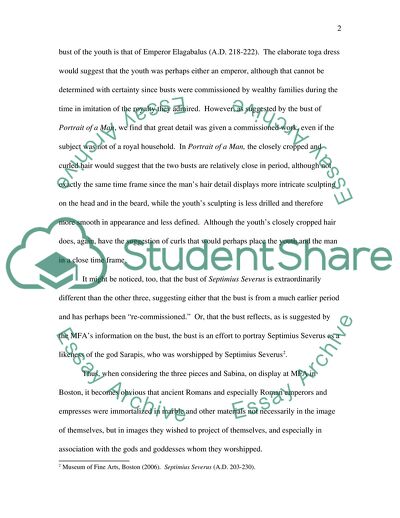
- Home
- Free Samples
- Premium Essays
- Editing Services
- Extra Tools
- Essay Writing Help
- About Us
MFA - Essay Example

- Subject: Miscellaneous
- Type: Essay
- Level: Undergraduate
- Pages: 4 (1000 words)
- Downloads: 0
- Author: glenrau
Extract of sample "MFA"
Sculptures of the Roman royals were often commissioned not to reflect the image of the person as they appeared at the time of the sculpture, but rather in an image that was to immortalize and one which they would be remembered as. To appear more youthful than mature, and beautiful so as to have that lasting image in the minds of the Roman subjects of their Empress when, in fact, the Empress died at a relatively mature age, having borne no children to her husband, the Emperor Hadrian. Sabina, herself coming from a royal background related to the Emperor Trajan, was just twelve years old when she was married by arrangement to Hadrian, in order that Trajan’s blood line continue1.
In conjunction with the other sculptures from the Imperial Period on display with Sabina, The Portrait of a Youth, which, like Sabina’s statue, is in remarkably good condition. The young man’s hair, cropped close, but curled, and brushed forward slightly onto the forehead would be the youthful imitation of the period. It is suggested that the bust of the youth is that of Emperor Elagabalus (A.D. 218-222). The elaborate toga dress would suggest that the youth was perhaps either an emperor, although that cannot be determined with certainty since busts were commissioned by wealthy families during the time in imitation of the royalty they admired.
However, as suggested by the bust of Portrait of a Man, we find that great detail was given a commissioned work, even if the subject was not of a royal household. In Portrait of a Man, the closely cropped and curled hair would suggest that the two busts are relatively close in period, although not exactly the same time frame since the man’s hair detail displays more intricate sculpting on the head and in the beard, while the youth’s sculpting is less drilled and therefore more smooth in appearance and less defined.
Although the
...Download file to see next pages Read MoreCHECK THESE SAMPLES OF MFA
Review of Aphrodite And The Gods of Love Exhibit at the MFA in Boston
Cessation of Multi-Fibre Agreement
Multi-Fibre Agreement Impact on the European Economy
Retrospection of Art History
MFA Program in Film and Video Production
Guidelines Drawn Up to Govern the Trade
Due diligence: provenance of museums collections
The Multi-Fibre Agreement

- TERMS & CONDITIONS
- PRIVACY POLICY
- COOKIES POLICY